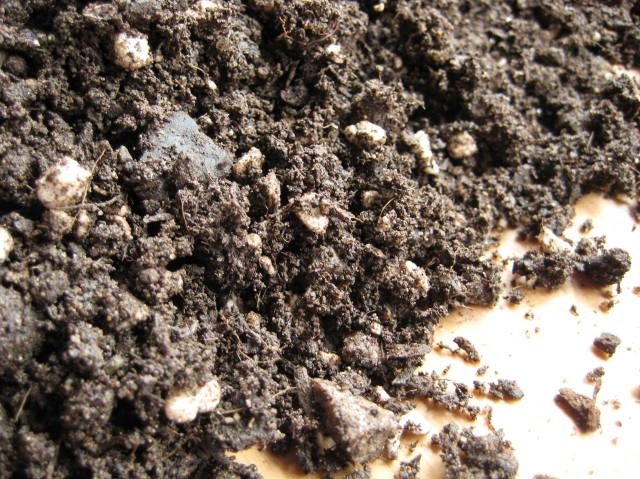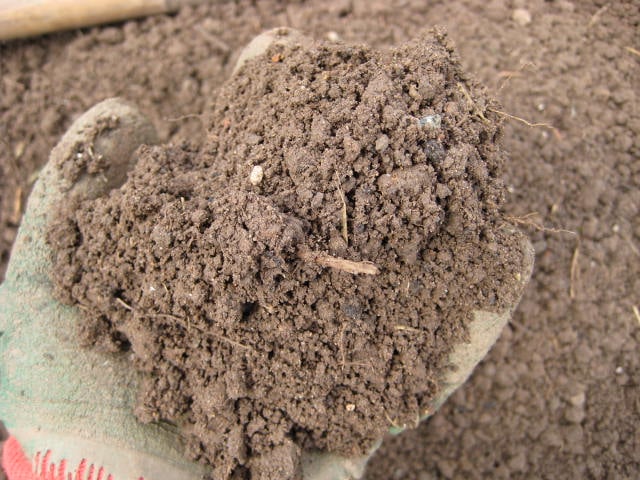Alpine compost
Posted on
Compost for alpine plants.
Dishing the dirt - our thoughts on compost.
 |
I am often asked what compost I use for growing our plants and I usually reply, 'Oh, it's a secret recipe!' And so it is. I can tell you the basic ingredients (and will do later) but for now it's a John Innes type compost or soil-based compost. With added ingredients. One of those is Perlite (the white granules you can see here), more about that later. This is a very expensive mixture and no large-scale producer could contemplate using it but we are only small-scale. Price isn't a consideration for us - we want to grow the best plants we can and we can't do do that by penny-pinching, especially on such a basic thing as what sustains the plants. |
First, a bit of history. Back in the day, last century and before, loam was what growers used as a base for their composts. Loam is basically soil and they 'improved' it with various additions - peat, leaf-mould, sand, grit, cow manure, crushed (clay) pots - in fact a long list of things, each added to hopefully give the grower the results he or she desired. There was no standard recipe to follow, each grower concocted their own recipe.
Lawrence and Newell, two helpful chaps who worked at the John Innes Research Institute, decided to research compost mixes. Their research ended with them producing a standard compost recipe which could be followed by any grower and give good results for a wide range of crops. And so we have John Innes composts, normally abbreviated to J.I. no.1, J.I. no 2 and J.I. no. 3, the numbers referring only to the level of fertilisers contained in each. And still today, decades after their introduction, we refer to those mixes.
You may be thinking that we use a John Innes compost - wrong! For our conditions and the alpines we grow, a standard compost is unsuitable - not free draining enough, wrong fertiliser content etc., etc. We grow so many different plants from different parts of the world and in conditions that probably aren't ideal. Growing plants in pots is fairly artificial after all and when J.I. mixes were developed everyone used terracotta clay plant pots (which were porous and 'breathed'), not plastic pots. Another reason we reject J.I. is the variability of the loam used. Traditionally, the loam (or soil) was turves of grass cut from a meadow, stacked in layers with layers of manure and left for several months or more before use. That was wonderful stuff - full of fibres from decayed grass roots, naturally rich in almost all the nutrient plants require and with a 'crumb' structure that allowed good drainage. Now, it is more likely to be top soil of possibly indifferent quality stripped from land destined for house building.
Loam (or soil) obviously varies from area to area - you can probably tell that from your own garden. The original J.I. requirements were for a medium clay loam, stripped from grass ley (established pasture). Now, I suspect that most manufacturers use a sandier soil, but clay is the magic ingredient. It is mainly the clay fraction that provides and holds on to nutrients and retains water. But clay is heavy (gardeners talk about a heavy clay soil and it is physically heavier) and can be difficult to handle, especially if it's wet. Loam requires to be sifted before use to remove stones etc. and wet clay is impossible to sieve.
 |
So, what do we use at Craigiehall Nursery? Well, we do use loam as a base for our composts. And here it is - in its raw state after being riddled (sieved). This is marvellous stuff and I produce it myself - my hand inside that glove! . The loam is dug up and stacked. Later it is chopped up, riddled (sieved) into a wheelbarrow then shovelled into our soil steriliser where the heat kills any weed seeds and anything harmful. Once cooled, it is bagged up for later use. It's hard work! But I can do most of it during the winter months when we are less busy. |
That is a lot of manual handling and like I say, it's hard work. Why do I do it, especially when alternatives are widely available? Well, we simply can't buy material like this and it is such wonderful stuff that we prefer not to compromise on how we grow our plants. Proper, sterilised loam makes such a difference to how plants grow, how they keep growing and how they establish in the garden once planted.
Used on it's own, loam would be totally unsuitable for growing in pots - much too dense, it would 'slump' or compact in the pot, excluding the air that plants roots need. So we add things to the loam to give us the desired results we need. The John Innes recipe called for sphagnum moss peat but we prefer not to use peat. Its use is controversial to say the least and, rightly or wrongly, environmentalists will lobby government to ban its use all together. That process has started already and is well under way. So, instead of peat we use a peat-free compost. It is actually manufactured by one of the large commercial compost manufacturers and is based on coir (coconut husks), recycled wood waste and composted bark. We have tried it on its own but results were poor results although others report excellent success with it.
So, we have loam and green compost. Together these provide nutrients and water-holding whilst still being reasonable free-draining. But alpine plants like good drainage so we add coarse sand to the mix. And grit. We also add Perlite, a form of volcanic rock that is heated and forms small white granules - you can see these in the top image above. These hold some water but even when saturated they also hold a high proportion of air. Finally, we add lime (to neutralise acidity) and nutrients to suit the plants' needs. Part of the fertiliser is a long-life, slow release fertiliser that will last the plants for over a year from potting. Everything gets thoroughly mixed together in our compost mixer, the only mechanised part of the whole process. Like I say in our About Us section of our website, everything we do is hand crafted, including our compost mix. It's not just one mix of course, we vary the proportions and fertilisers according to plant need.
So there we have it - a unique product. It has taken us a long time to arrive at this point. Furthermore, I think it is sustainable. Whether it is 'green' or environmentally sound is debatable. Grit and sand need to be quarried. Loam is a finite resource but we are very small scale and have supplies to last us a century! Perlite is mined too and what's more the production of it requires heating the rock to very high temperatures which must use huge amounts of energy. I am told that there are unlimited supplies of coir in the world but it all requires shipping from abroad. What doesn't these days? Scottish grown alpine plants!
